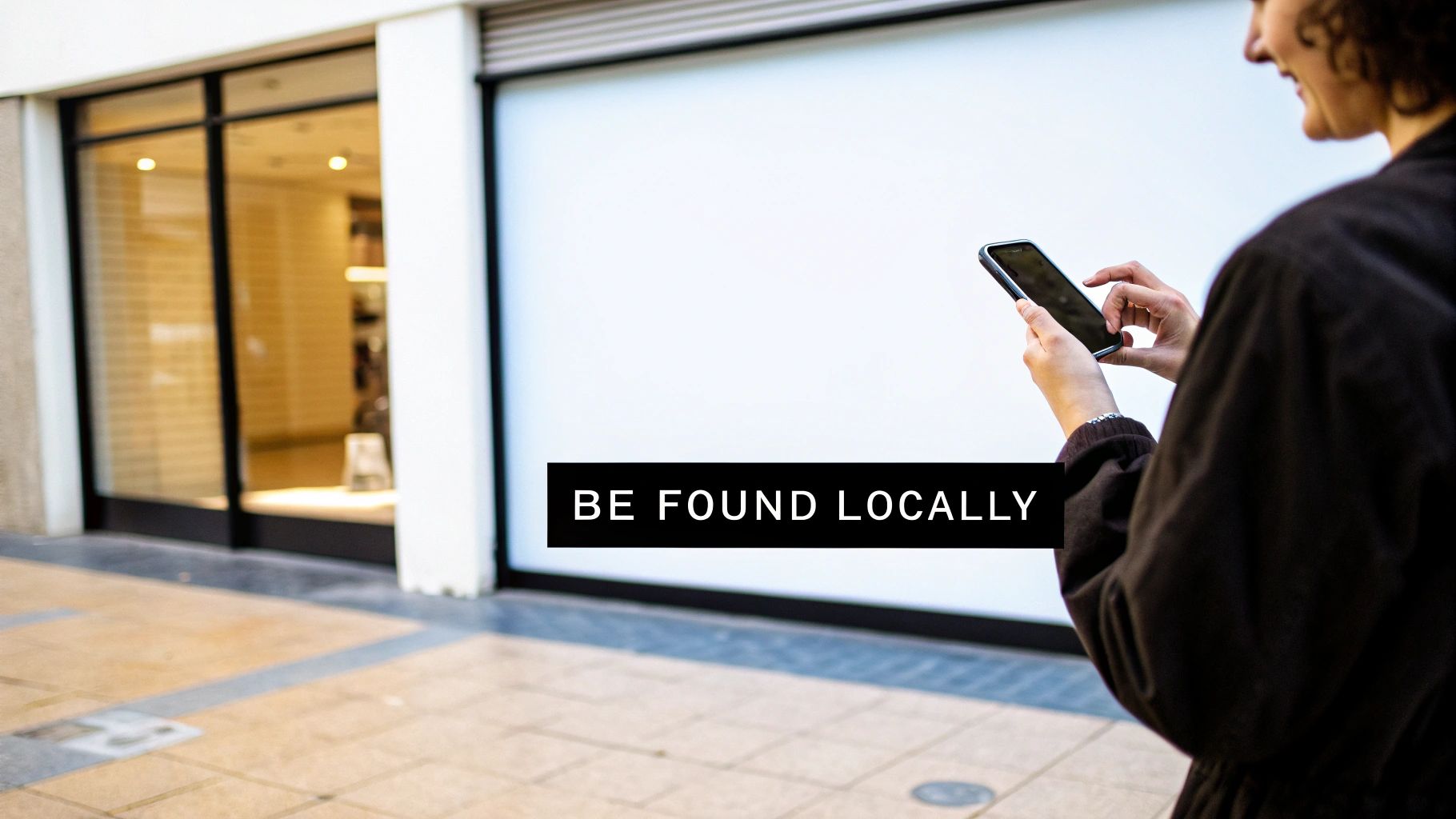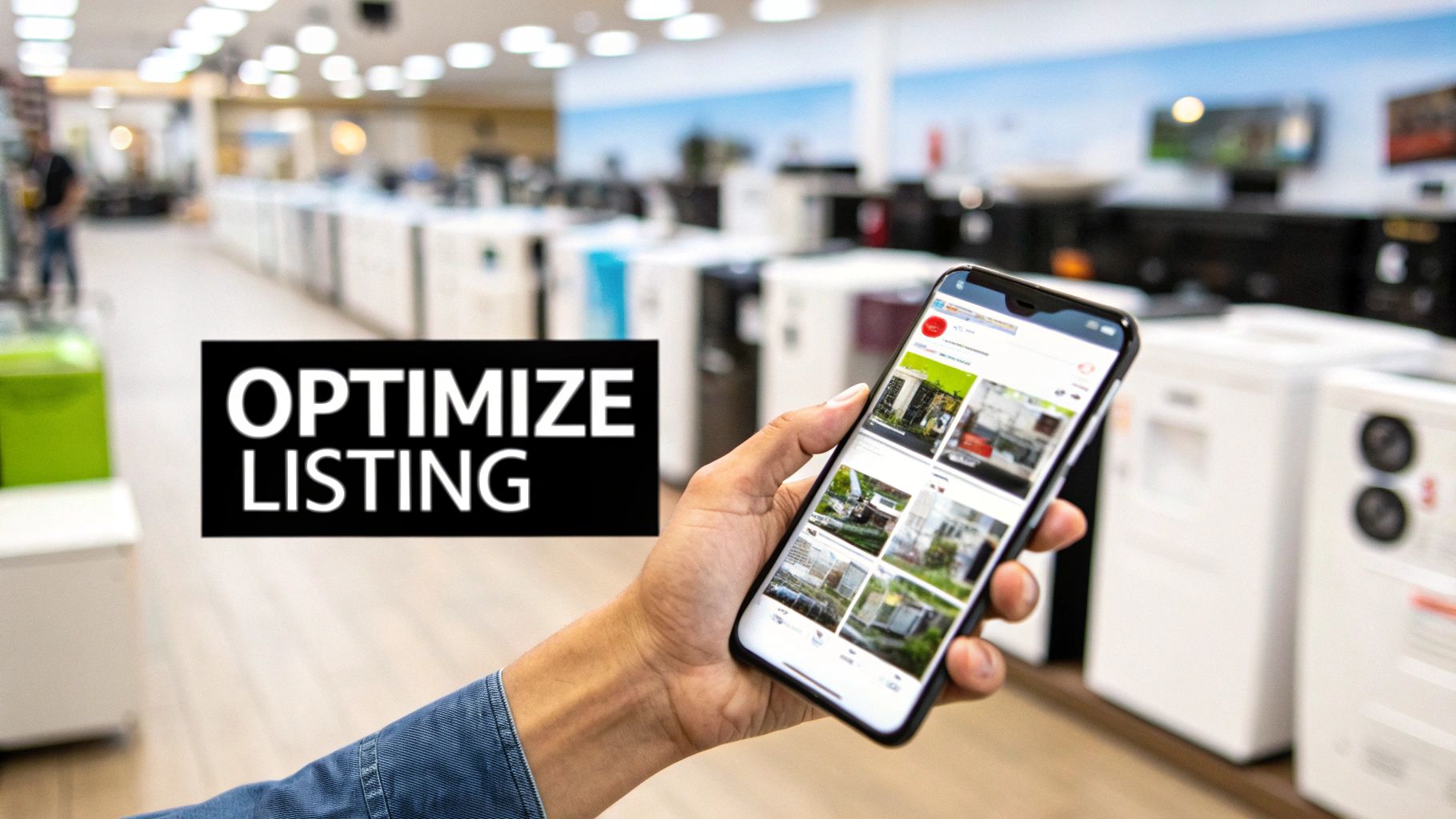
How to Get a Google Business Listing From Start to Finish
Share
To get a Google Business Listing, you'll need to create a profile, fill in your business details, and then go through a quick verification step—Google usually sends a postcard to your address. This free tool is easily the most powerful way to show up in local Google searches and on Google Maps, basically acting as your digital storefront.
Why Your Google Business Profile Is a Must-Have Asset

Before we get into the nuts and bolts of setting one up, let’s be clear on why this profile is non-negotiable for a restaurant equipment supplier. I've seen a lot of B2B owners dismiss it as something for restaurants or coffee shops, but it’s just as vital for suppliers. Think of it as your digital front door. It’s the very first impression a potential client gets when they search for "commercial oven supplier near me."
This profile is where they'll find your showroom address, check your hours, and—most importantly—read reviews from other local restaurant owners. A complete, active profile builds instant trust. That’s huge when a single sale can be worth tens of thousands of dollars. It’s the foundation of your entire local marketing strategy. For a deeper dive, our guide on what is local SEO explains how all these pieces fit together: https://restaurantequipmentseo.com/blogs/restaurant-equipment-seo-blog/what-is-local-seo.
The Path From Search to Sale
Let's walk through a real-world scenario. A local restaurant owner, Maria, has her convection oven die on her right in the middle of a busy lunch service. It's a crisis.
She grabs her phone and immediately searches for a local supplier. The first thing she sees is Google's "Local Pack"—that map with three business listings at the top. If your profile is properly optimized, you’ll be one of them.
Why does she click on your listing? Because it has:
- High-quality photos of your showroom and the actual equipment you stock.
- A solid 4.8-star rating with recent, positive reviews.
- Your correct phone number and address, showing you're just a 15-minute drive away.
Within minutes, she’s on the phone with your sales team. This direct path, from a frantic search to a high-value lead, is powered entirely by your Google Business Profile.
The Power of Verification and Trust
What started as Google My Business back in 2014 has become the absolute cornerstone for local visibility. The data doesn't lie: businesses with verified listings are seven times more likely to get clicks and engagement than those without one.
Verification is a powerful signal. It tells both Google and your customers that you're a legitimate, active business they can rely on.
A well-maintained profile is more than just a listing; it's a dynamic sales tool that works for you 24/7, building the authority needed to stand out. While a Google profile is key, see how it fits into a broader growth plan with this comprehensive guide to digital transformation for small businesses.
Creating Your Google Business Profile From Scratch
Alright, let's get your Google Business listing built from the ground up. This part of the guide is all about getting it done right the first time, focusing on the specific choices that matter most for a B2B supplier like you.
First things first, you'll need to head over to the official Google Business Profile page to get started.

This is your launchpad. Once you click that "Manage now" button, you’ll be asked to sign in with a Google account, and the process will kick off.
Finding Your Business and Avoiding Duplicates
Google's first question will be for your business name. As you start typing, it'll search for any profiles that already exist. Pay close attention here—this is a critical step.
If a profile for your business pops up, maybe one a former employee made years ago or one Google automatically generated, do not create a new one. Duplicate listings are a huge headache. They confuse Google, split your hard-earned reviews, and make you look unprofessional to potential customers.
Instead, you’ll need to claim that existing profile. Google has a straightforward process for requesting ownership from whoever currently manages it. It's an essential move for keeping your online presence clean and authoritative.
If nothing shows up, great! You can move forward with creating a brand-new profile from scratch.
Selecting the Right Business Category
Choosing your primary business category is probably the single most important decision you'll make during this whole setup. It’s how you tell Google exactly what you do and, more importantly, which searches you should show up for.
For a restaurant equipment supplier, the best choice is specific but often overlooked. Too many suppliers default to a generic category like "Retail Store," which is a huge mistake. You need to be precise.
- Primary Category: Go with "Restaurant Supply Store." This is a direct signal to Google that you serve a very specific professional niche.
- Secondary Categories: After that, add others that fit, like "Commercial Refrigeration Supplier" or "Kitchen Supply Store," to catch customers looking for those specific product lines.
Put yourself in your customer's shoes. A restaurant owner isn't searching for a generic "retail store"; they're looking for a "restaurant supply store" near them. Getting your category right is what gets you in front of that high-value search.
Your primary category is the bedrock of your local SEO. It's the strongest signal you can send to Google about your core business. Get this wrong, and you're suddenly competing against hardware stores and clothing boutiques, making it nearly impossible to rank for the keywords that actually drive your business.
Adding Your Physical Location
Next up is your business address. If you have a physical showroom where clients can visit, this is simple—just enter the exact street address. It’s absolutely vital that this address is identical to what's listed on your website and other online business directories. Consistency is key.
Here’s a common trap to avoid: don't even think about using a P.O. Box or a virtual office address. Google's rules require a legitimate physical location where you can actually interact with customers. Trying to game the system with a non-compliant address is one of the quickest ways to get your entire listing suspended, wiping out all your progress.
Stick to your real, physical business address. It’s the only way to build long-term trust with both Google and your customers.
How to Navigate the Google Verification Process
https://www.youtube.com/embed/qtsdxn22wEI
After you’ve plugged in your initial business details, you’ll run into the most critical checkpoint: verification. This is where Google makes sure you're a real business operating where you say you are. Think of it as the final step before you can truly go live. Getting verified unlocks all the good stuff—responding to reviews, adding photos of your equipment, and actually showing up when a local chef is searching for a new convection oven.
The Old-School Postcard Method
For most new listings, Google still relies on a surprisingly low-tech method: sending a postcard to your business address. It feels a bit dated, but it's their go-to for confirming a physical location.
You'll request the postcard right from your profile dashboard. It usually shows up in about 5 to 7 business days with a unique PIN inside. Once you have it, just log back in, pop in the code, and you're officially on the map.
One crucial piece of advice I always give clients: Do not change your business name, address, or primary category while waiting for that postcard. Making any of those edits can reset the clock and you'll be right back at square one, waiting for another piece of mail.
What If I Get Other Verification Options?
While the postcard is the default, it's not the only game in town. Depending on what Google can already find about your business online, you might get a faster, digital option. Don't be surprised if one of these pops up:
- Phone Call or Text: A code is sent directly to your official business phone number. This is usually offered to more established businesses with a consistent phone number listed across the web.
-
Email: Google sends a verification code to an email address on your business domain (think
sales@your-company-name.com). A personal Gmail account won't cut it for this. - Video Verification: This is becoming more and more common. You'll need to record a short, continuous video that proves your business is real.
I recently helped a new equipment supplier get verified this way. The owner had to shoot a quick video that started outside showing their permanent sign, then showed him unlocking the door, walking inside to show off the warehouse full of inventory, and finally, panning over to a company vehicle with their logo on it. It sounds like a lot, but it worked. Google had them verified within 48 hours.
Verification is what gets you in the game. Without it, your profile is essentially invisible to local customers. The method you're offered is a direct reflection of how much Google already trusts your business's digital footprint.
Troubleshooting When Things Go Wrong
Sometimes the process hits a snag. The most common headache? The postcard never shows up. If it's been more than two weeks, don't just sit and wait. Log back into your profile and you can request a new one.
If the second postcard also goes missing, it’s time to reach out to Google Business Profile support. Be ready to provide more concrete proof. They'll likely ask for things like a utility bill with your business name and address on it, or perhaps a copy of your business license.
It can be a bit of a grind, but stay patient. Getting your listing verified is non-negotiable for winning local customers, so it's well worth the effort.
Optimizing Your Profile to Win Local Search

Alright, getting your profile verified is a great first step, but it’s just the starting line. Now, it's time to turn that basic listing into a customer magnet that really stands out in local search. This is where the real work happens—feeding Google’s algorithm all the rich, detailed info it needs to see you as the go-to authority for restaurant equipment in your area.
The mission is simple: fill out every single relevant section. A complete profile isn’t just about looking professional; it's a massive ranking signal. Think of it from Google's perspective. If it has to choose between a profile with just a name and address versus one packed with photos, product listings, and a detailed description, it’s always going to favor the one that gives the user more value.
Craft a Compelling Business Description
You get 750 characters for your business description—make them count. This is your elevator pitch to potential customers, so it needs to be packed with the keywords they're actually searching for. Don't just settle for "restaurant equipment supplier." That's not enough.
Get specific. Talk about the equipment you specialize in, like "commercial refrigeration," "combi ovens," and "warewashing solutions." Mention who you serve—"independent restaurants, hotels, and institutional kitchens." This kind of detailed language helps Google perfectly match your business with serious buyers looking for exactly what you sell.
Select Your Categories with Precision
We touched on this during setup, but it’s so critical it bears repeating. Your primary category is arguably the single most important local ranking factor. I’ve seen it time and time again—the right category choice makes a world of difference.
Your primary category absolutely has to be "Restaurant Supply Store."
From there, you’ll want to layer in secondary categories that paint a fuller picture of your offerings. Think about adding things like:
- Commercial Refrigeration Supplier
- Cooking Equipment Supplier
- Food Service Equipment Supplier
These additional categories act like signposts, guiding Google to show your profile for a much wider range of specific searches. Getting your categories right is foundational. It’s also crucial that this information is identical everywhere else online, which is a key part of citation building. You can learn more about how to build local citations in our dedicated guide here: https://restaurantequipmentseo.com/blogs/restaurant-equipment-seo-blog/build-local-citations.
Showcase Your Products and Showroom with High-Quality Photos
Photos are what transform a generic listing into a tangible, real-world business. For a restaurant equipment supplier, this is a golden opportunity to build trust and show off what you've got. Please don't just upload a logo and a picture of your storefront and call it a day.
Give your customers a virtual tour of your business.
- Your Showroom: Take wide, bright shots of your showroom floor. Let people see the variety of equipment you have on display.
- Product Close-Ups: Get detailed photos of key items like a six-burner range or the control panel of a combi oven. Show the quality.
- Your Team in Action: A photo of your sales team helping a client adds a much-needed human touch and builds instant credibility.
- Your Warehouse: Showing the scale of your operation with pictures of a well-stocked warehouse signals that you have inventory ready to ship.
The impact of a complete and active profile is undeniable. Businesses that dominate the top three local search positions often have over 200 reviews on their Google Business Profile. Completeness and engagement, especially having a robust photo gallery, directly contribute to this kind of success.
Leverage the Products Feature
The "Products" feature is one of the most underused tools by B2B suppliers, but it’s an absolute game-changer for your business. It allows you to create a virtual catalog right on your Google listing.
Instead of just saying you sell "ovens," create a specific product entry for a "Blodgett Convection Oven" with its own photo, a solid description, and even a price range. Do this for your best-sellers—your commercial ice machines, your stainless steel prep tables, your high-temp dishwashers.
Each product you add becomes another keyword-rich asset that helps you rank for those specific, high-intent searches. To really boost your visibility beyond just profile tweaks, check out some effective Google marketing hacks designed to bring in more local customers.
To help you stay on track, I've put together a checklist of the most important optimization tasks. It’s prioritized based on what will give you the biggest bang for your buck in local search.
Google Business Profile Optimization Checklist
A prioritized list of optimization tasks and their impact on local search visibility, helping you focus on what matters most.
| Optimization Task | Impact Level | Example for a Restaurant Supplier |
|---|---|---|
| Select Primary Category | High | Set to "Restaurant Supply Store" |
| Add High-Quality Photos | High | Upload showroom, product, and team photos (aim for 20+) |
| Build Out Product Catalog | High | Create entries for top 10-15 products with photos & descriptions |
| Write Business Description | Medium | Include keywords like "commercial refrigeration" and "warewashing" |
| Add Secondary Categories | Medium | Add "Cooking Equipment Supplier," "Food Service Equipment," etc. |
| Fill Out All Business Info | Medium | Complete service areas, hours, phone number, and website |
| Enable Messaging Feature | Low | Allow customers to send direct messages for quick quotes |
This checklist isn't exhaustive, but tackling these items—especially the high-impact ones—will put you miles ahead of most competitors who just set it and forget it. Consistent effort here pays off.
Keeping Your Listing Active to Engage Customers

Getting your Google Business Profile set up and optimized is a great start, but it’s just that—a start. The real work begins now. A static, forgotten profile is practically invisible to both Google and your potential customers.
Google’s algorithm absolutely rewards businesses that are active and engaged. Consistent updates send strong signals that you’re open, responsive, and ready to help. This ongoing management is what separates the top-ranking profiles from the ones that get buried on page three of the search results.
It’s these small, consistent efforts that drive long-term performance and turn your listing into a lead-generating machine. If you've put in the work but still aren't getting the visibility you expect, you can dig into some common reasons why your business isn't showing up on Google.
Use Google Posts to Showcase Your Expertise
Think of Google Posts as your business’s mini-blog, right there on your search listing. This is your chance to announce new product arrivals, like a shipment of the latest combi ovens, or to share helpful content. You can highlight special financing offers for new restaurateurs or even promote your booth at an upcoming industry trade show.
The key is consistency. Posting regularly shows both customers and Google that your business is humming along. It’s shocking, but 60% of businesses have never even used this feature, leaving a massive opportunity on the table. With Google's search becoming more AI-driven, profiles with fresh content get a serious leg up.
Master Your Reviews and Build Social Proof
Actively asking for and responding to every single review is non-negotiable. Positive reviews are fantastic social proof that can sway a purchasing decision, but how you handle the negative ones can be even more powerful.
A prompt, professional response to a bad review can turn a complaint into a public display of your excellent customer service. Never let a review, good or bad, sit unanswered. Thank customers for positive feedback and address complaints directly with a solution-focused attitude. This active management builds immense trust and shows potential clients you stand behind your equipment and your word.
Control the Narrative with the Q&A Feature
The Questions & Answers section of your profile is a goldmine for controlling the information customers see first. Don't just sit back and wait for people to ask questions—be proactive. Think about the most common questions your sales team fields every day, and then add them to your profile yourself. From there, you can post clear, comprehensive answers.
By seeding your own Q&A, you can preemptively address key concerns and highlight your unique selling points. You control the narrative from the very beginning.
Here are a few questions you should probably add right away:
- "Do you offer equipment installation and training?"
- "What financing options are available for new restaurants?"
- "Is your showroom open to the public, or do I need an appointment?"
Answering these upfront saves everyone time and immediately positions you as a helpful expert. Consistent activity across Posts, Reviews, and Q&A transforms your profile from a simple business listing into a dynamic hub that attracts and converts high-value customers.
Common Questions (and Answers) About Your Google Business Profile
When you're trying to get your Google Business Profile just right, a few common questions always seem to pop up. Let's walk through some of the tricky spots you might run into.
One of the most stressful things is getting that dreaded "Your listing has been suspended" email. It's a jolt, for sure. This usually happens for a specific reason—maybe you used a P.O. Box for your address, or perhaps you got a little too creative and stuffed keywords into your business name. The trick is to stay calm, dig into Google's official guidelines, figure out what you did wrong, fix it, and then submit a reinstatement request. You'll need to show proof you've corrected the problem.
Then there's the issue of negative reviews. It's tempting to just ignore them and hope they go away, but that's the worst thing you can do. A better approach is to respond quickly and keep it professional. Acknowledge their complaint, offer a way to make it right, and try to move the conversation to a phone call or email. This signals to everyone else reading the reviews that you take customer service seriously.
Can I Get a Listing Without a Physical Address?
Yes, you definitely can, and this is a huge deal for many restaurant equipment suppliers. If you operate out of a warehouse or office without a showroom and deliver directly to your clients, this feature is built for you. Google calls these Service Area Businesses (SABs).
During setup, you'll provide your actual address for Google's verification process (they'll probably mail you a postcard), but then you can choose to hide it from the public on your profile.
Instead of a map pin showing your warehouse, your profile will display a shaded service area that you define. You can set this by city, zip code, or even a specific mile radius around your home base. This gets you in front of local customers without broadcasting an address you don't want them showing up to.
How Do I Deal With Duplicate Listings?
Finding a duplicate listing for your business is a common, and incredibly annoying, problem. It can split your customer reviews, confuse potential buyers, and weaken your search ranking. Duplicates often get created by accident—maybe a former employee set one up years ago, or Google’s algorithm automatically generated one.
First, do a quick search for your business name on Google and Google Maps. If you spot a rogue profile, don't just create a new one and hope for the best. You need to claim the existing one.
Look for a link that says "Own this business?" on the duplicate profile and follow the prompts. You'll have to request access from whoever currently "owns" it. If you don't hear back after three days, Google usually gives you the option to go through the verification process yourself and take control.
At Restaurant Equipment SEO, we handle the nitty-gritty details of Google Business Profile management so you can get back to running your business. Our goal is to turn your profile into a consistent source of qualified leads.
Ready to make your local search presence a real asset? Visit us at https://restaurantequipmentseo.com to see how we help suppliers dominate their markets.